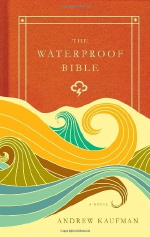 I read The Waterproof Bible so long ago now that it feels like forever, but it’s so good, and since I’m already behind schedule anyway, I thought, fuck it, let’s write about it. I sprung for the hardcover, which I almost never do, but in this case it was worth it. Rather than your typical big-publisher hardback with an undistinguished cloth cover and a dust jacket with a pretty picture that will get ignored or damaged or lost, Random House made something that looks like the kind of thing McSweeney’s would have put together, with some really lovely gold leaf and a clever belly band that’s actually thematically relevant. The stock isn’t quite as good as what McSweeney’s would have used, but then McSweeney’s would have charged an additional ten bills for it, too. Anyway, the thing is gorgeous.
I read The Waterproof Bible so long ago now that it feels like forever, but it’s so good, and since I’m already behind schedule anyway, I thought, fuck it, let’s write about it. I sprung for the hardcover, which I almost never do, but in this case it was worth it. Rather than your typical big-publisher hardback with an undistinguished cloth cover and a dust jacket with a pretty picture that will get ignored or damaged or lost, Random House made something that looks like the kind of thing McSweeney’s would have put together, with some really lovely gold leaf and a clever belly band that’s actually thematically relevant. The stock isn’t quite as good as what McSweeney’s would have used, but then McSweeney’s would have charged an additional ten bills for it, too. Anyway, the thing is gorgeous.
This is the bit where I’m supposed to tell you what the book is about, and who Kaufman is, and things like that. All I know about Kaufman is that he’s written a couple of novellas (All My Friends Are Superheroes, in 2003, and The Tiny Wife, in 2010) and that he’s got a Twitter account. And really, that’s enough, yeah? So the book: The Waterproof Bible is about some extraordinary people who are also incredibly ordinary. Or something. It’s about a frog driving a car, who is not really a frog, but is really driving a car. It’s about a woman who projects her emotions into the world in the most literal of ways, and who protects herself and her memories with talismans. It’s about a man building a boat in the middle of the prairie, and it’s about some people—also not really frogs—who live under the sea, and about people who can call down the rain. The way I see it, you’ve got two ways to go: you can be intrigued by this information, as I was, or you can not be intrigued by this information, and let one of the most enjoyable reading experiences of the last two years fly right on by. It’s up to you, really. And by that I mean shut up and buy the book.
It’s really, really tempting to read The Waterproof Bible as an allegory, or collection of allegories or extended metaphors or something. Kaufman invites the reader in, with Rebecca and her emoting in particular, and he makes you want to try on their circumstances like a suit, to see how they fit and where things line up, and to see what that tells you about yourself. They won’t fit. You can understand Aby’s crisis of faith, or Lewis’ revelations, but no matter what angle you choose to approach them from, they’re never going to be able to say anything about your own faith directly. What they will do is nag at you and make you dig deeper and make you look at yourself and think about things and ask questions you maybe didn’t know were yours for the asking. I found this to be particularly true when reading about Rebecca, her dead sister Lisa, and Stewart, who stayed out there in the drought and waited for Rebecca and the storm.
Kaufman will do all these things, and you won’t even know it’s happening, because The Waterproof Bible reads like a light, mostly comic romp. It doesn’t feel like this big weighty thing that will command feelings to rise up from the bottom of wherever to stir up some silt, it feels like the kind of book you’ll take the to the beach to read in an afternoon with a glass of zinfandel and some wasabi peas, chuckling softly to yourself at the funny bits. That’s what I did. Well, not really what I did; my life doesn’t look anything like that. I read it in a damp basement with some music on, a glass of Coke, and some Creamy Dill Old Dutch potato chips, but you get the idea.
The Waterproof Bible was my tenth selection for the Fourth Canadian Reading Challenge.